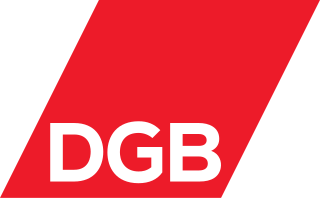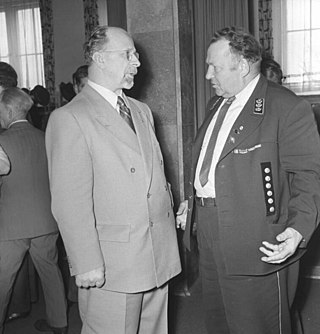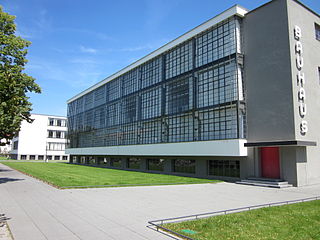
The German Trade Union Confederation is an umbrella organisation for eight German trade unions, in total representing more than 6 million people. It was founded in Munich, 12 October 1949.

Hans Emil "Hannes" Meyer was a Swiss architect and second director of the Bauhaus Dessau from 1928 to 1930.

Bernau bei Berlin is a town in the Barnim district in Brandenburg in eastern Germany, located about 10 km (6.2 mi) northeast of Berlin.
Trade unions in Germany have a history reaching back to the German revolution in 1848, and still play an important role in the German economy and society.

Arieh Sharon was an Israeli architect and winner of the Israel Prize for Architecture in 1962. Sharon was a critical contributor to the early architecture in Israel and the leader of the first master plan of the young state, reporting to then Prime Minister, David Ben-Gurion. Sharon studied at the Bauhaus in Dessau under Walter Gropius and Hannes Meyer and on his return to Israel in 1931, started building in the International Style, better known locally as the Bauhaus style of Tel Aviv. Sharon built private houses, cinemas and in 1937 his first hospital, a field in which he specialized in his later career, planning and constructing many of the country's largest medical centers.

Charlotte Bischoff was a German Communist and Resistance fighter against National Socialism.
The General German Trade Union Federation was a confederation of German trade unions in Germany founded during the Weimar Republic. It was founded in 1919 and was initially powerful enough to organize a general strike in 1920 against a right-wing coup d'état. After the 1929 Wall Street crash, the ensuing global financial crisis caused widespread unemployment. The ADGB suffered a dramatic loss of membership, both from unemployment and political squabbles. By the time the Nazis seized control of the government, the ADGB's leadership had distanced itself from the Social Democratic Party of Germany (SPD) and was openly cooperating with Nazis in an attempt to keep the organization alive. Nonetheless, on May 2, 1933, the SA and SS stormed the offices of the ADGB and its member trade unions, seized their assets and arrested their leaders, crushing the organization.

The ADGB Trade Union School, is a training centre complex in Bernau bei Berlin, Germany. It was built for the former General German Trade Union Federation, from 1928 to 1930. It is a textbook example of Bauhaus functionalist architecture, both in the finished product and in the analytical and collaborative approach used to develop the design and complete the project. Next to the Bauhaus Dessau building, it was the second-largest project ever undertaken by the Bauhaus.
Luise Ermisch (born Luise Thürmer; 20 May 1916 in Halle – 17 January 2001 in Mühlhausen was a German political activist and later a senior politician in the German Democratic Republic, who balanced her political career with an ongoing involvement in the clothing industry.

Erich Grützner was an East German Trades unionist and a senior official in the country's ruling SED (party).
Lothar Lindner is a former German trade union leader. He was chairman of the central committee of the building and timber industry union in the East German Free German Trade Union Federation and President of the International Federation of Unions in the building, timber and building materials industries in the World Federation of Trade Unions (WFTU).
Grete Groh-Kummerlöw was a German politician.
Horst Heintze was a German trades union official and politician. Through the union movement he rose to become a member of the People's Chamber (Volkskammer) in the German Democratic Republic and, from 1963, a member of the powerful Party Central Committee. He was unusual in rising this far through the power structure of the country despite having been a Nazi Party member in his youth.

Edmund Collein was an East German architect and urban planner. He is also known for his photography while studying at the Bauhaus art school.
Erich Consemüller was a German photographer and architect who studied and taught at Bauhaus art school. He worked alongside the photographer Lucia Moholy documenting life at the Bauhaus.
Marlies Deneke is a German politician.

Josef Wenig was a German labour and political activist (KPD). After 1945 he became an important figure in the East German political establishment. He was a member of the ruling party's powerful Central Committee between 1954 and his death in 1981. He was also a member of the country's National Parliament ("Volkskammer") between 1950 and 1981.

Adolf Hennecke, was an official of the German FDGB and of the Socialist Unity Party of Germany. He gave his name to the Hennecke movement, the German Democratic Republic's Stakhanovite activist movement.

Bauhaus and its Sites in Weimar, Dessau and Bernau is a World Heritage Site in Germany, comprising six separate sites which are associated with the Bauhaus art school. It was designated in 1996 with four initial sites, and in 2017 two further sites were added.
Heinz Oehler was a German trade union leader.














